Kitchen splashback cost comparison, types and ideas
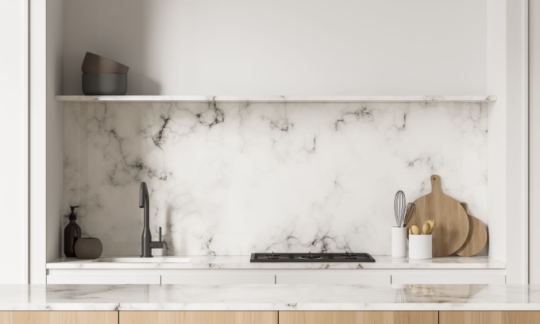
If you’re looking to add an extra element of visual appeal to your kitchen, a splashback can be an attractive and practical option. You may be wondering – what does a splashback cost, and what kind might be best to suit your particular requirements and tastes?
What is a splashback and what does it do?
A splashback is what its name suggests – a hard, durable wall surface in the kitchen designed to be impervious to splashes of food, water or other substances from the stovetop, kitchen sink, and other high-work areas. It is usually an essential companion to the stovetop, to prevent hot food from damaging the wall behind it. It is usually made from a hard-wearing substance, such as glazed tiles, glass, stone or metal, so it can be easily cleaned often but still maintain its good looks. And looks can be important – the splashback can end up as a main feature of the decor, depending on its size and position in the kitchen.
What does a splashback cost?
According to trade website HiPages, the cost of a splashback can vary significantly depending on the kind of materials you use, ranging anywhere from $45 per m2 to $250 per m2 or above, with engineered stone likely to be on the more expensive end of potential options. They break down approximate splashback cost by materials as follows:
- Tile: $45 – $250 per m2
- Laminate: $230 per m2
- Acrylic: $247 per m2
- Metaline: $300 – $350 per m2
- Glass: $330 – $420 per m2
- Stainless steel: $330 per m2
- Engineered stone: $390 per m2
It is important to keep in mind that the cost of installation will be in addition to these material costs.
Which splashback is best for my kitchen?
When choosing your splashback, in addition to considering the cost, it’s a good idea to first work out what it needs to do. Will it cope with being constantly wet, as may happen if its above the sink? Is it in a showy part of the kitchen that will need to pack extra decor punch? Is it in a gloomy corner and therefore colour choice will be important?
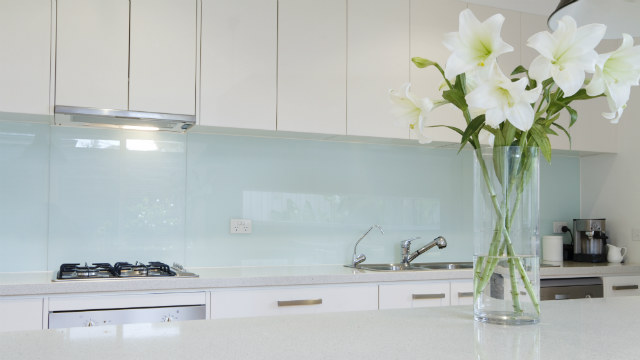
If it’s on the wall behind the stovetop, it may also need to comply with strict government standards, particularly if the stove is fuelled by gas. But wherever its positioned, it will probably also need to be high-heat resistant, dint/smash/chip proof and easy to clean – even to scrub when sticky substances such as toffee splutter from a bubbling pot. When it comes to the way it looks, the good news is that there are no hard-and-fast rules, although some splashbacks could be better suited to certain types of kitchens. Glass splashbacks, for example, might look better in modern kitchens, while pressed-metal splashbacks might be more suited to kitchens in heritage properties.
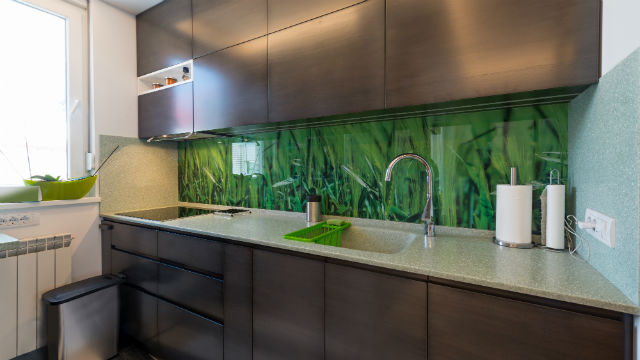
Choose a colour that will match the other elements in the room if you want the splashback to blend in with the decor. To show it off, choose a contrasting colour, pattern or texture. To add artistic flair, you could even consider adding custom touches, such as getting a digital print made for display behind the glass of a splashback (as pictured above).
What tiles should I use for my splashback?
Tiles are a practical choice for a splashback, and there are a plethora of options available. Walk into a tile store and you’ll be spoilt for choice when it comes to shapes, sizes, colours and materials.
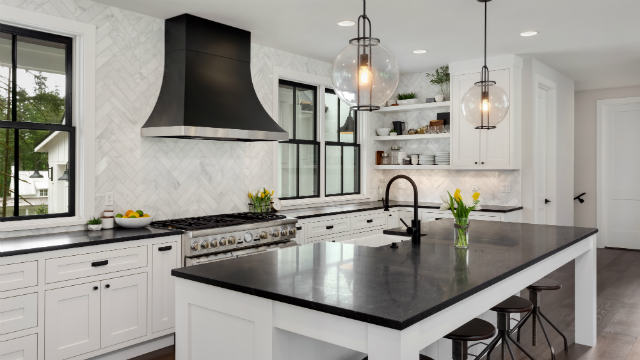
The herringbone pattern – where rectangular tiles are laid in a zigzag formation (pictured above) – has made a big comeback in recent years and can make a bigger impact when it reaches all the way to the ceiling. Mosaic, honeycomb, square, Moroccan and large tiles can also be used to great effect on splashbacks – it all comes down to personal preference.
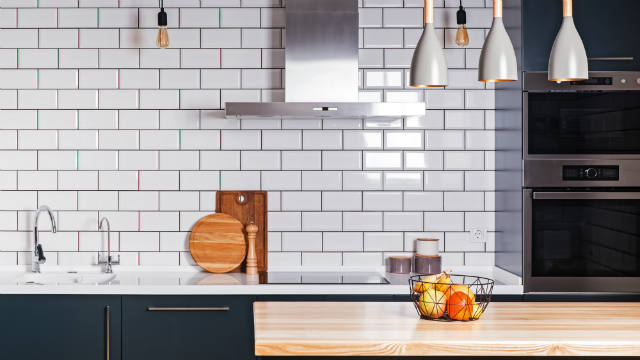
Another popular choice right now is subway tiles (as shown above). This timeless kitchen splashback inspired by New York’s subway stations suits almost every kitchen. It’s chic, stylish and won’t break the bank. White tiles with a light grout will give a more tonal look but is harder to keep clean, while a darker grout will add contrast and hide discolouration, especially behind the stovetop. If you’re feeling daring, consider using turquoise or black tiles instead.
Can you use marble as a splashback?
If a luxury kitchen is what you’re after, some would say there is no going past a marble splashback.
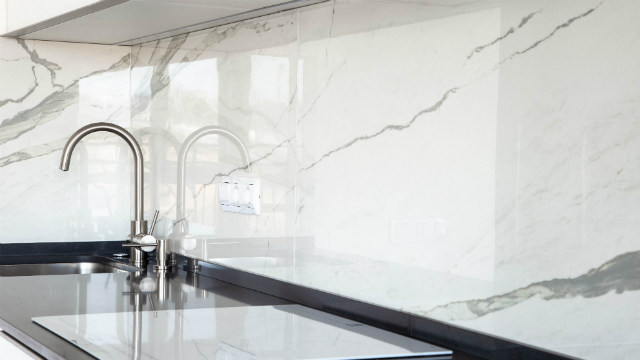
You could match it to your marble benchtops or choose a colour that will complement or contrast with other materials in the room. However, keep in mind that natural marble can be more porous and prone to staining than other types of stone or man-made surfaces, and it may need special coatings and care to keep it looking smart.
Manufactured stone can also be a great choice for a splashback, and the good news is that it does not have to be as thick as a slab used for a benchtop.
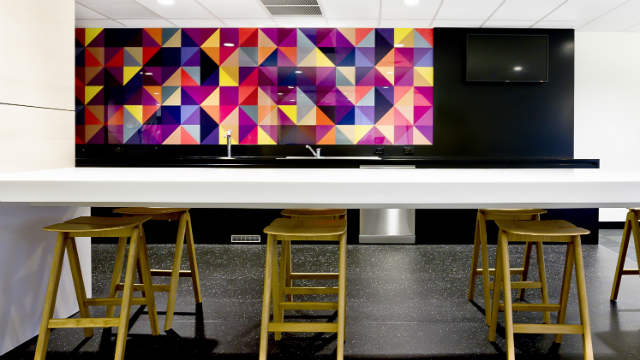
What if I want to make a statement with my splashback?
Coloured glass can add a point of difference to your kitchen, particularly if you’ve decided to go with neutral colours for the rest of the decor.
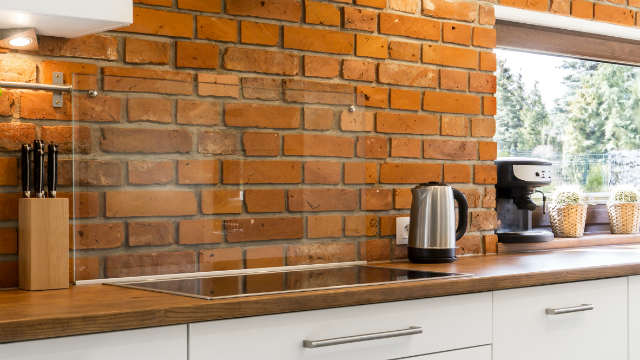
Or, you may wish to use clear glass to let the bones of your home shine through. Covering brick walls with a piece of toughened glass can help keep that section of the wall free of hard-to-remove food splatter and keep the bricks free from oil stains, which can prove permanent.
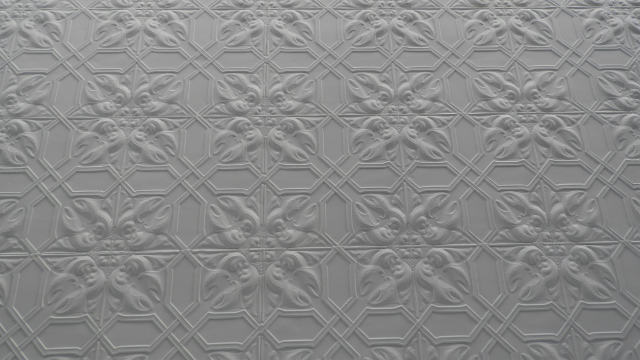
You might like to add some wow factor to your kitchen with a pressed metal splashback (pictured above). Traditionally used on ceilings, it’s being used more and more in the kitchen, often as a nod to a renovated home’s heritage past.
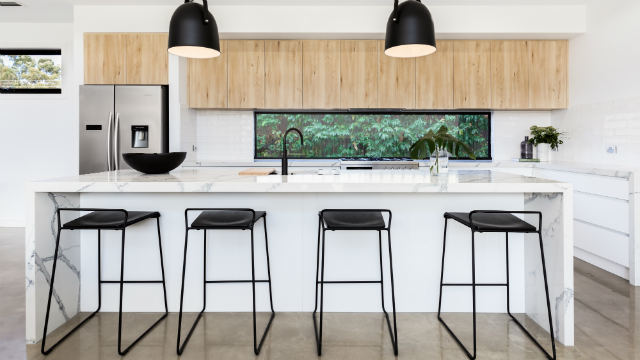
Do I even need a splashback?
There may be some cases where a typical splashback, as described above, may not even be necessary. If you’re lucky enough to be building your kitchen from scratch, you might consider using a window for your splashback. It can allow lots of natural light into the room and, with some clever landscaping, can provide a connection to the garden or some strategically placed pot plants outside.
However, keep in mind that building standards may impact on whether or not a window can be used in this way. Check with your builder or local building authority.
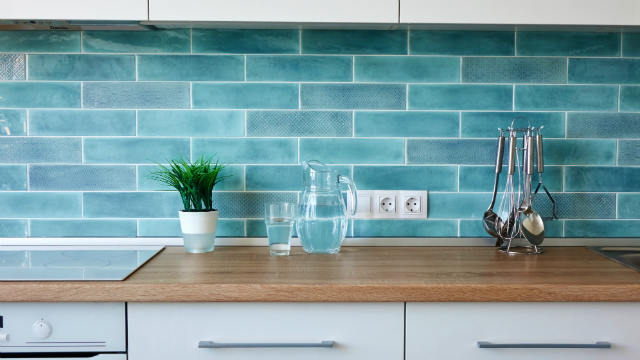
How much does installing a splashback cost?
How much it will cost to install a new splashback depends on a number of factors, including if there is an existing splashback that has to be removed, the material you wish to use for your new splashback, where it has to be installed, and if a professional has to do the work, as well as how many cut-outs (for things such as power points) are required.
HiPages estimates that you might expect to pay anywhere between $450 to $900 for a splashback installation, depending on how complex the job is, and the cost of preparing the surface that you plan to install the splashback on.
You may have to remove the existing wall covering before installing the new splashback. If the surface is uneven or damaged, it may need to be repaired, depending on what splashback material you intend to use, and the repairs necessary. There could also be a callout fee.
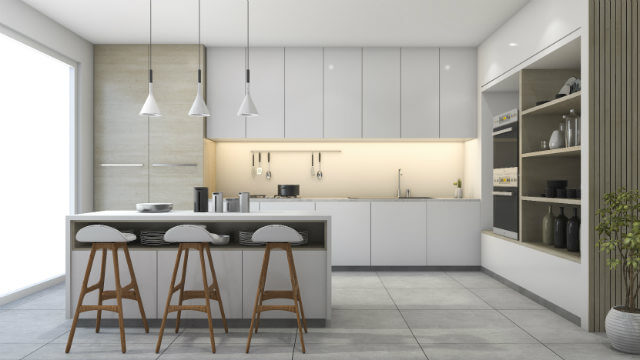
What are some options to pay for splashback installation?
Whether you are simply installing the splashback by itself, or going all out and renovating the entire kitchen, it’s wise to consider how you might finance the work before you start.
Options could include:
- Paying out of your own pocket – using your savings or a mortgage offset account or redraw facility, if you have one on your home loan;
- Refinancing your home loan; or
- Applying for a new loan – you may be able to use a personal loan or a construction loan, depending on your personal circumstances.
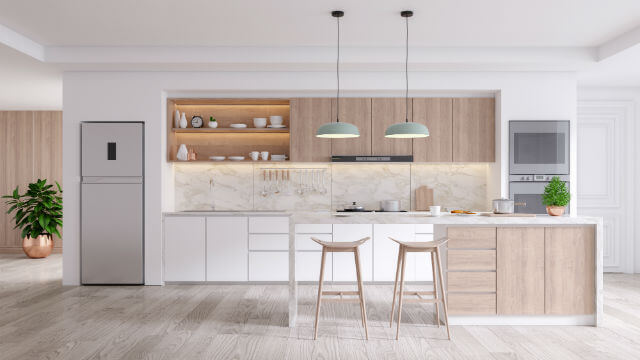
The comparison rate for all home loans and loans secured against real property are based on secured credit of $150,000 and a term of 25 years.
^WARNING: This comparison rate is true only for the examples given and may not include all fees and charges. Different terms, fees or other loan amounts might result in a different comparison rate.

Up to $4,000 when you take out a IMB home loan. Minimum loan amounts and LVR restrictions apply. Offer available until further notice. See provider website for full details. Exclusions, terms and conditions apply.
 Owner occupied
Owner occupied
 20% min deposit
20% min deposit
 Redraw facility
Redraw facility
 Owner occupied
Owner occupied
 10% min deposit
10% min deposit
 Redraw facility
Redraw facility
 Owner occupied
Owner occupied
 50% min deposit
50% min deposit
 Redraw facility
Redraw facility
 Owner occupied
Owner occupied
 20% min deposit
20% min deposit
 Redraw facility
Redraw facility
 Owner occupied
Owner occupied
 30% min deposit
30% min deposit
 Redraw facility
Redraw facility
 Owner occupied
Owner occupied
 30% min deposit
30% min deposit
 Redraw facility
Redraw facility
Canstar may earn a fee for referrals from its website tables, and from Sponsorship or Promotion of certain products. Fees payable by product providers for referrals and Sponsorship or Promotion may vary between providers, website position, and revenue model. Sponsorship or Promotion fees may be higher than referral fees. Sponsored or Promoted products are clearly disclosed as such on website pages. They may appear in a number of areas of the website such as in comparison tables, on hub pages and in articles. Sponsored or Promoted products may be displayed in a fixed position in a table, regardless of the product’s rating, price or other attributes. The table position of a Sponsored or Promoted product does not indicate any ranking or rating by Canstar. For more information please see How We Get Paid.
Cover image source: United Photo Studio/Shutterstock.com
This article was reviewed by our Editor-in-Chief Nina Tovey before it was updated, as part of our fact-checking process.

Alasdair Duncan is Canstar's Deputy Finance Editor, specialising in home loans, property and lifestyle topics. He has written more than 500 articles for Canstar and his work is widely referenced by other publishers and media outlets, including Yahoo Finance, The New Daily, The Motley Fool and Sky News. He has featured as a guest author for property website homely.com.au.
In his more than 15 years working in the media, Alasdair has written for a broad range of publications. Before joining Canstar, he was a News Editor at Pedestrian.TV, part of Australia’s leading youth media group. His work has also appeared on ABC News, Junkee, Rolling Stone, Kotaku, the Sydney Star Observer and The Brag. He has a Bachelor of Laws (Honours) and a Bachelor of Arts with a major in Journalism from the University of Queensland.
When he is not writing about finance for Canstar, Alasdair can probably be found at the beach with his two dogs or listening to podcasts about pop music. You can follow Alasdair on LinkedIn.
- What is a splashback and what does it do?
- What does a splashback cost?
- Which splashback is best for my kitchen?
- What tiles should I use for my splashback?
- Can you use marble as a splashback?
- What if I want to make a statement with my splashback?
- Do I even need a splashback?
- How much does installing a splashback cost?
- What are some options to pay for splashback installation?
The comparison rate for all home loans and loans secured against real property are based on secured credit of $150,000 and a term of 25 years.
^WARNING: This comparison rate is true only for the examples given and may not include all fees and charges. Different terms, fees or other loan amounts might result in a different comparison rate.
 Owner occupied
Owner occupied
 50% min deposit
50% min deposit
 Redraw facility
Redraw facility
Try our Home Loans comparison tool to instantly compare Canstar expert rated options.
The comparison rate for all home loans and loans secured against real property are based on secured credit of $150,000 and a term of 25 years.
^WARNING: This comparison rate is true only for the examples given and may not include all fees and charges. Different terms, fees or other loan amounts might result in a different comparison rate.






